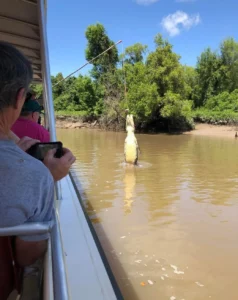
For outdoor enthusiasts seeking an unforgettable experience, camping in Litchfield National Park presents an enticing opportunity. Nestled in the Northern Territory of Australia, this park offers a unique blend of natural waterfalls, diverse wildlife, and picturesque landscapes that beckon adventurers year-round. Whether you’re pitching a tent under the stars or parking your caravan for a family holiday, Litchfield will leave you in awe. This guide will help you find the best camping spots, prepare adequately for your adventure, and ensure you don’t miss the fascinating Litchfield National Park tours that will accentuate your outdoor excursion.
Introduction to Camping in Litchfield National Park

Litchfield National Park, a haven for camping aficionados, provides a plethora of options for reconnecting with nature. With several campgrounds that cater to diverse preferences, you are sure to find a spot that resonates with your camping style. The park is not only celebrated for its tranquility but also for its accessibility and the warmth of the local flora and fauna. By choosing Litchfield as your camping destination, you are signing up for a journey filled with exploration, relaxation, and the joy of the great outdoors.
Why Litchfield National Park is a Camper’s Paradise
A true camper’s paradise, Litchfield National Park encompasses an array of natural wonders, from cascading waterfalls and crystal-clear pools to beguiling boulders and historic sites. The park’s layout ensures that each campground is uniquely positioned, offering visitors an intimate experience with the wild. Here, you can bask in the sounds of nature, from the serene song of dawn’s first light to the chorus of nocturnal wildlife. What’s more, the rich cultural heritage of the area adds an educational twist to your natural adventure.
Understanding the Best Seasons for Camping in Litchfield
Determining the optimal time to camp at Litchfield National Park is crucial. Although the park is open year-round, the dry season, typically from May to September, offers the most comfortable climatic conditions for camping. Fewer pests, lower humidity, and easier accessibility to attractions, including key sites for Litchfield National Park tours, make the dry season a preferred period for many campers. Conversely, during the wet season, from October to April, some areas may be inaccessible due to flooding, and the heat and humidity can be intense.
Preparing for Your Camping Trip
Effective planning is vital to ensure you have a safe and enjoyable camping trip in Litchfield National Park. It starts with drafting a checklist of necessary gear, familiarizing oneself with the campsite’s specifics, and being mindful of the park’s rules and regulations. The remoteness of some camping spots requires you to be self-sufficient and to anticipate your needs during your stay. Remember, the more prepared you are, the smoother your camping adventure will be.
Essential Camping Gear for Litchfield National Park
- Durable tent with a rain fly and groundsheet
- Comfortable sleeping bags suited to the season
- Portable cooking equipment and sufficient food supplies
- Ample water containers to hold drinking and utility water
- Reliable navigation tools like a map and compass
- First-aid kit for treating minor injuries
Having the right gear can make a significant difference in your camping experience. It’s essential to choose equipment that is appropriate for the region’s climate and the type of camping you’ll be doing. In Litchfield, where the weather can vary, water-resistant materials and adequate hydration solutions are particularly important.
Permits, Fees, and Regulations for Campers
Before you head out, ensure you have the necessary permits and are ready to pay any applicable fees. Some campsites may be operated on a first-come, first-served basis, whereas others require reservations. Always adhere to the park’s regulations, which are designed to protect the natural environment and enhance visitor safety. These can include but are not limited to, rules regarding campfires, fishing, and interacting with wildlife.
Safety Tips and Wildlife Awareness
Your safety while camping should always be a priority. Litchfield National Park is home to a variety of wildlife, including potentially dangerous species. It’s important to be wildlife aware, keeping a respectful distance, securing food properly, and never feeding the animals. Additionally, always inform someone of your travel plans and expected return.
How to Minimize Your Environmental Impact While Camping
Park authorities promote a ‘leave no trace’ ethos, encouraging campers to minimize their environmental footprint. This involves packing out all your trash, using biodegradable hygiene products, avoiding the removal of natural resources, and being mindful of your water and energy use. By respecting these practices, you contribute to the preservation of the park’s pristine condition for future visitors.
Top Campsites in Litchfield National Park
Litchfield National Park, located in Australia’s Northern Territory, offers a variety of campsites that cater to different types of adventurers. From family-friendly sites with full amenities to more secluded spots for those seeking a closer connection with nature, Litchfield has something for every camper. The park is known for its stunning waterfalls, crystal-clear swimming holes, and rugged bushland, making it a perfect spot for camping enthusiasts.
- Wangi Falls Campground:Most popular due to its proximity to the famous Wangi Falls, offering both powered and unpowered sites.
- Buley Rockhole Campsite:Ideal for those who enjoy water activities, close to cascading waterfalls and rock pools.
- Florence Falls Campground:Offers a quieter experience with access to spectacular swimming and hiking areas.
- Tjaynera Falls (Sandy Creek) Campground:Accessible by 4WD only, perfect for a more secluded, off-the-grid camping experience.
- Surprise Creek Campground:Small and remote, suitable for those looking to escape the crowds and enjoy tranquility.
Tips for Securing a Campsite During Peak Seasons
- Book well in advance to guarantee a spot.
- Consider camping on weekdays rather than weekends.
- Be flexible with your dates or choice of campsite.
- Pre-plan your itinerary and Litchfield National Park tours to align with your camping spot.
- Stay informed on the campsite’s occupancy by checking park bulletins.
Since Litchfield National Park is a favored camping destination, fast action and strategic planning are key to securing your ideal campsite, especially during holiday periods or school vacations.
Outdoor Activities and Attractions Near Campsites
Litchfield National Park is not just about camping; it’s a hotspot for various outdoor activities. Many campsites are close to attractions and offer a wealth of opportunities to engage with nature. Below is a table highlighting the activities and their proximities to different campsites.
ActivityWangi Falls CampgroundFlorence Falls CampgroundBuley Rockhole CampsiteTjaynera Falls CampgroundWaterfall SwimmingOnsiteShort walkShort driveShort hikeHiking TrailsMultiple nearbyMultiple nearbyMultiple nearbyLimitedTermite Mounds ViewingShort driveShort driveShort driveAccessible by 4WDBird WatchingExcellentExcellentExcellentExcellent
Conclusion to Camping in Litchfield National Park
Litchfield National Park is an exceptional camping destination that offers something for everyone. With its majestic waterfalls, rich biodiversity, and engaging Litchfield National Park tours, campers can enjoy a truly immersive outdoor experience. The variety of campsites ensures that whether you seek adventure, serenity, or a mix of both, Litchfield is equipped to provide the perfect setting for your camping escapade. Always remember to camp responsibly and preserve the park’s natural beauty for all to relish.
The allure of camping in Litchfield National Park is undeniable. With its easily accessible campsites, proximity to natural wonders, and the promise of an authentic bush experience, it’s the ideal backdrop for creating lasting memories. By being well-prepared and environmentally conscious, campers can enjoy all that this Northern Territory jewel has to offer. The park is not only a place to stay; it’s an invitation to explore, relax, and connect with the great outdoors. Ready your gear, set your itinerary, and embark on a Litchfield adventure that will captivate your heart and rejuvenate your spirit.
FAQs
What is the best time of year to camp in Litchfield National Park?
The dry season, extending from May to September, offers the ideal climate for camping, with less humidity, cooler temperatures, and minimum rain, enhancing accessibility and comfort.
Do I need to book a campsite in advance?
It is prudent to book your campsite well in advance, especially during peak seasons, to ensure you secure a spot. This can typically be done online or through the park’s management.
Are there any facilities available at the campsites?
Facilities vary across different campsites, ranging from basic toilets and picnic tables to more comprehensive amenities such as shower facilities and barbecue areas.
Can I have a campfire at my campsite in Litchfield National Park?
While campfires are allowed in designated areas, it’s essential to comply with the current fire regulations and restrictions during your stay, which can vary throughout the year.
What should I do in case of a wildlife encounter?
In case of a wildlife encounter, maintain a safe distance, avoid feeding or provoking the animal, and if necessary, quietly back away without turning your back to the creature.

